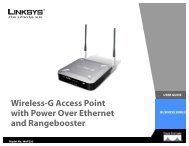Cisco Small Business RV 120W Wireless-N VPN Firewall ...
Cisco Small Business RV 120W Wireless-N VPN Firewall ...
Cisco Small Business RV 120W Wireless-N VPN Firewall ...
You also want an ePaper? Increase the reach of your titles
YUMPU automatically turns print PDFs into web optimized ePapers that Google loves.
Configuring Virtual Private Networks (<strong>VPN</strong>s) and SecurityConfiguring Advanced <strong>VPN</strong> Parameters5• Auto Policy—Some parameters for the <strong>VPN</strong> tunnel are generatedautomatically. This requires using the IKE (Internet Key Exchange) protocolto perform negotiations between the two <strong>VPN</strong> Endpoints.• Manual Policy—All settings (including the keys) for the <strong>VPN</strong> tunnel aremanually input for each end point. No third-party server or organization isinvolved.To create an Auto <strong>VPN</strong> Policy, you need to first create an IKE policy and then addthe corresponding Auto Policy for that IKE Policy. (See Auto Policy Parameters,page 102.)STEP 5STEP 6In the Remote Endpoint field, select the type of identifier that you want to providefor the gateway at the remote endpoint: IP Address or FQDN (Fully QualifiedDomain Name).In the NetBIOS field, check the Enable box to allow NetBIOS broadcasts to travelover the <strong>VPN</strong> tunnel, or uncheck this box to disable NetBIOS broadcasts over the<strong>VPN</strong> tunnel. For client policies, the NetBIOS feature is available by default.Local Traffic Selection and Remote Traffic SectionSTEP 1For both of these sections, configure the following settings:• Local/Remote IP—Select the type of identifier that you want to provide forthe endpoint:- Any—Specifies that the policy is for traffic from the given end point(local or remote). Note that selecting Any for both local and remote endpoints is not valid.- Single—Limits the policy to one host. Enter the IP address of the hostthat will be part of the <strong>VPN</strong> in Start IP Address field.- Range—Allows computers within an IP address range to connect to the<strong>VPN</strong>. Enter the Start IP Address and End IP Address in the providedfields.- Subnet—Allows an entire subnet to connect to the <strong>VPN</strong>. Enter thenetwork address in the Start IP Address field, and enter the SubnetMask in the Subnet Mask field.STEP 2In the Start Address field, enter the first IP address in the range. If you selectedSingle, enter the single IP address in this field and leave the End IP Address fieldblank.<strong>Cisco</strong> <strong>RV</strong><strong>120W</strong> Administration Guide 99
















